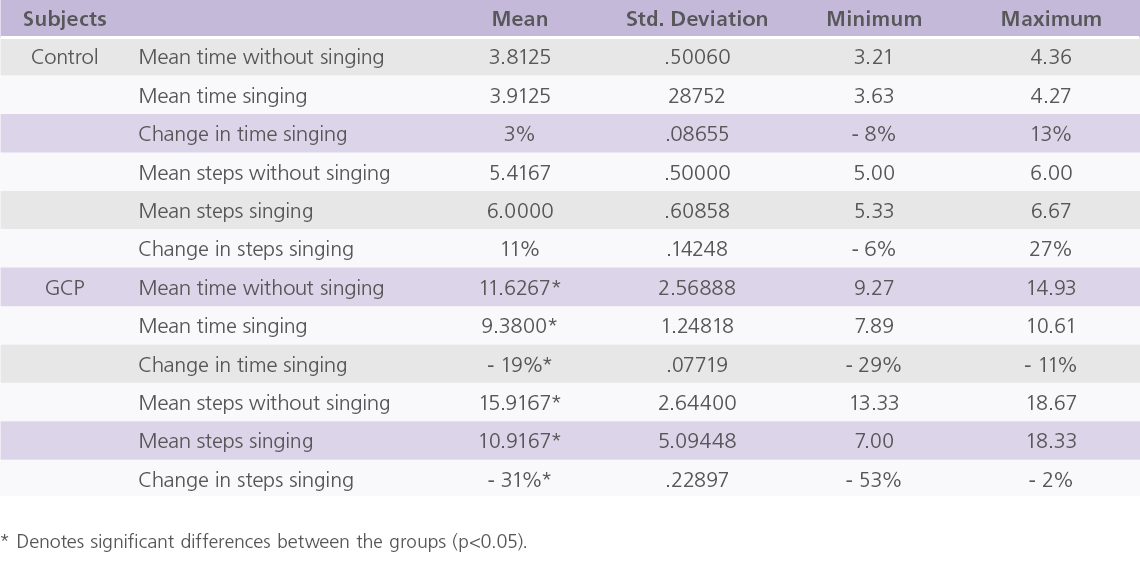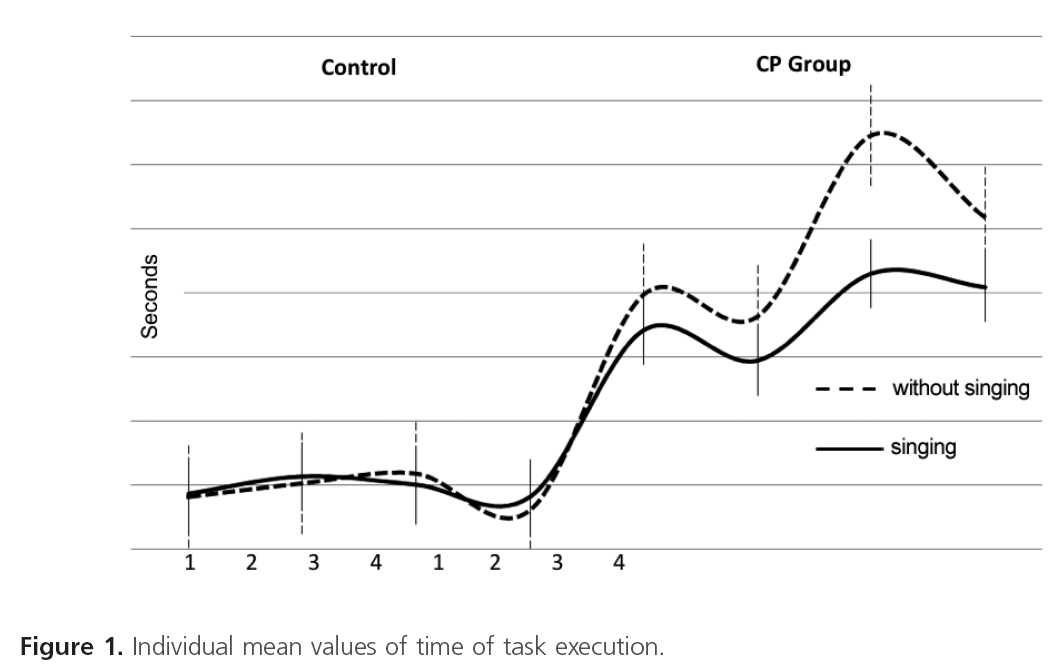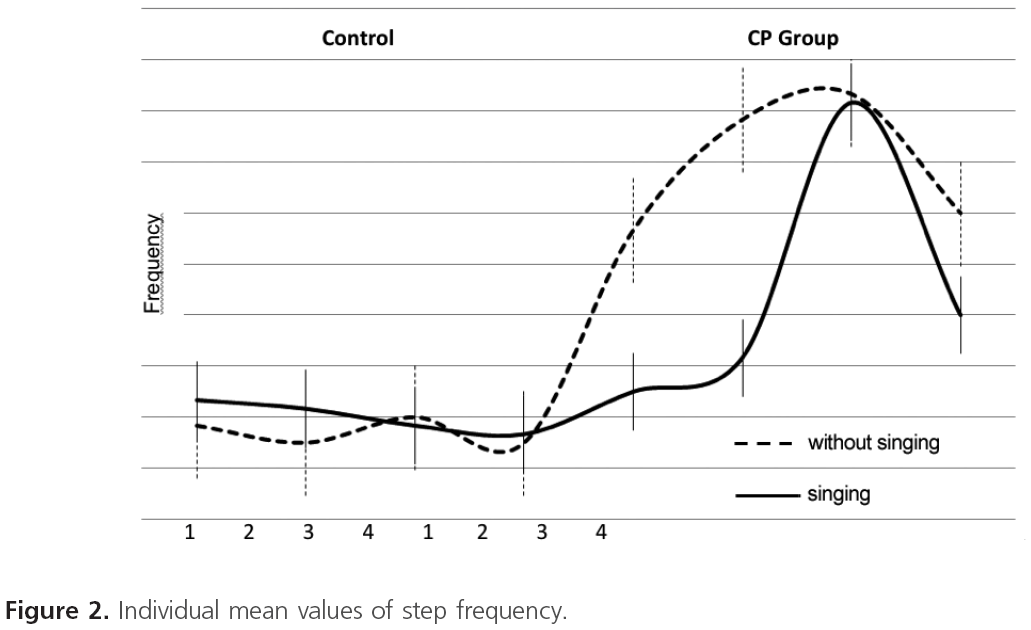Keywords
Physiotherapy, Music, Gait, Cerebral Palsy, Motor Activity.
Introduction
Cerebral palsy (CP) describes a group of permanent disorders of the development of movement and posture, causing activity limitation, that are attributed to non-progressive disturbances that occurred in the developing fetal or infant brain. The motor disorders of cerebral palsy are often accompanied by disturbances of sensation, perception, cognition, communication, and behavior, by epilepsy, and by secondary musculoskeletal problems [14].
CP is characterized as causing various difficulties in the coordination of muscle action, with the resulting inability of the child to maintain posture and execute functional movements [4].
Thus, functional independence, or at least the assessment of development potential that each individual has for mobility, whether transfer or movement, is an important part of the treatment goals of an interdisciplinary team for rehabilitation of the child with CP. Considering functionality, it should be emphasized that human gait is one of the basic components of the independent functioning of the human being, and therefore is an object of study and focus of clinical intervention in many studies in the area of rehabilitation [17, 20].
According to Grahn [7], music is organized in time, having rhythmic beats that occur at predictable and consistent intervals. A network of neural areas, including motor regions, is regularly implicated in basic timing as well as processing of musical rhythm. This quality enables music to be used as a marker of time for physical activity. Rhythmic stimuli control the timing associated with the neural activation of motor movements and these can be enhanced since the rhythm provides suggestions for the predictability of motor movements.
In walking, basic rhythm corresponds to the same sounds in succession, in which the speed of execution may be varied. Children with motor difficulties can benefit from an organized rhythm of music to provide more specific and synchronized movements during the exchange of steps and performance of walking [11].
Thus, this study aimed to determine the influence of music on speed and steps of children with CP.
Method
This study was approved by the Ethics and Research committee of the Universidade Cidade de São Paulo (UNICID) under CAAE - 0002.0.254.186-08 and developed through the signing of free and informed consent signed by legal guardian of the participants.
Case records
The study included eight children divided into two groups: The group with cerebral palsy (GCP) was formed by four children (2 girls and 2 boys) with a medical diagnosis of spastic diplegic-type CP, aged between 6 and 12 years. The group control consisted of four children with no motor impairment, and was matched for sex and gender with GCP.
Inclusion criteria: medical diagnosis with CP spastic diplegia; levels II according to the Gross Motor Function Classification System (GMFCS). The GMFCS was translated into Portuguese by Hiratuk, [8] and classifies children with CP into five levels according to motor function. This means that all the children assessed were able to walk without the aid of mobility devices
Exclusion criteria were: presence of osteoarticularstructured deformities in the hip, knee or ankle; surgery or chemical neuromuscular blocking within six months; other associated diseases; and children with alterations in cognitive functions that would impede in the collaboration and understanding of simple orders in the activities proposed.
Instruments
The assessment used to measure the gait of the individuals was an adaptation of the Timed Up and Go Test (TUG), which measures functional mobility that involves balance, muscle strength of the lower limbs and gait speed. Thus, the child was asked to rise from a chair without using their arms and walk three meters, stop, turn, go back and return sitting, while the time, in seconds, to perform this task is timed [2]. This test was designed by Mathias, Nayac & Isaacs [11] and modified by Podsiadlo and Richardson [13].
Accordingly, the time spent to perform the test is directly associated with the level of functional mobility. Reduced time in testing will indicate individuals as independent in terms of mobility. Individuals who take longer than 14 seconds to perform the test tend to be more dependent in their daily tasks [16, 19].
To enable the application of the test in CP, there was change only in the place of departure. As children have difficulty rising from chairs made for adults, we decided to perform the initial and final position on a bench without armrest, considering the ideal height that the child can remain seated with the legs and thighs flexed 90°.
For this test we used a stopwatch to measure the time to stand and pedometer to count the number of steps. An electronic pedometer is a simple device, a mechanical counter that records the time and the movement of steps in response to vertical acceleration of the bod [12], and to estimate the number of steps taken by recording the vertical oscillations of the bod [5].
Procedure
The TUG test was applied three times to each individual, using the pedometer that was fixed in the region of the left anterior superior iliac crest and recording the time taken to perform the task. Timing ended when the individual acquired the starting position.
After three attempts, the test was repeated again three times, where the individual would have to walk and simultaneously sing a song of their choice and preference throughout the test.
Statistical analysis
We performed a descriptive analysis in each of the groups of the time and number of steps required to complete the task, as well as the percentage change in performance between both situations (singing and without singing). Kruskal-Wallis nonparametric tests were used to assess the differences between the groups and Wilcoxon were used to assess the differences within groups.
Results
Table 1 presents the descriptive data and comparison of the performance between groups. In intergroup comparisons, as expected, control completed the task in less time and with fewer number of steps than GCP in both situations (without singing and singing) (Kruskal-Wallis test, p <0.05). Also, the nonparametric Wilcoxon test found no statistically significant differences in the variables time and number of steps to complete the task when compared to situations without singing and singing. Nonetheless, there was statistically significant difference in percentage change in the performance of singing in comparison to without singing (Kruskal- Wallis test, p <0.05), with GCP, showing a mean reduction of 19% and 31% in time and number of steps, respectively.

Table 1: Means, standard deviations, and ranges for the group with CP (GCP) (n=4) and control (n=4).
Figures 1 and 2 show the analysis of individual performance, where there is a reduction in time (Figure 1) and the number of steps (Figure 2) in all subjects of GCP when performing the singing task.

Figure 1: Individual mean values of time of task execution.

Figure 2: Individual mean values of step frequency.
Discussion
It is important to clarify that in the activities of daily living, an individual’s involvement in two tasks simultaneously is common. The ability of dual-task performance (performing two tasks simultaneously) is highly advantageous and a prerequisite for a normal life [1, 6, 9]. The ability to execute and maintain gait while performing simultaneous cognitive, verbal, or motor tasks (dual-tasking) is beneficial in many ways. It is well-documented; however, dualtasking can result in cognitive or motor interference that results in diminished gait performance and impaired secondary task performance [1]. To perform a dual task is key to provide basic functionality on a daily basis and the investigation of the influence of dual tasks in CP is important in the organization of the treatment program.
When learning occurs, both tasks may be performed simultaneously without the loss of one or the other. If the performance of one of the activities is adversely affected, it implies that there was no automation, in which case the action of one of the proposed tasks is compromised. This worsening in functional performance is one of the consequences of dual activity, especially if the activity is new to the performer [15].
A change in motor learning during a dual task, especially when it combines cognitive and motor tasks, can be an important indicator of functional state found in an individual during a health state or during a period of rehabilitation. In the literature, this change is generally referred to as cognitive-motor interference [3].
After a cerebral lesion, cognitive-motor interference may occur, and easily automated activities begin to require a controlled process, with increased attentional demand and greater interference in motor performance, which implies compromise during the performance of dual tasks [18].
For this work, the authors decided to investigate the differences between the task of only walking comparing the influence of dual task (motor and cognitive), where individuals with CP executed walking along with singing a song of their choice. Thus, we chose to evaluate the runtime of the task and number of steps. It is important to note that the hypothesis was that both GCP and control would take more time and would use a greater number of steps in performing the dual task, with control presenting better performance. When analyzing the results, it was determined that GCP had completed the task with increased time when compared to control, but interestingly, GCP performed better considering the runtime of the task and number of steps during the performance of the singing task, apparently, the execution of two concurrent tasks facilitated the performance of GCP. Likely, the motivation factor, due to the use of singing during walking, was beneficial for the improvement of the task. Music has previously been known to mobilize the proposed activity by increasing concentration, where the beat of the music itself coincides with the increased gait of the patient.
Nonetheless, this study provides data that singing aided in performing the task of gait with reduced time and number of steps in individuals with CP. It should be clarified that this study was conducted with four children and that the quality of gait was not assessed. The incentive for further research is important with a larger group of participants to assess whether other factors involved in the mobility of children with CP are emotional, playful or physiological.
Conclusion
This study found as expected that control performed better than GCP. However, the children with CP showed a reduction of time and the number of steps in performing the dual task of gait and singing a song of their choice.
The quality of gait was not assessed, thus, there is incentive for further research with a larger group of participants. Moreover, other studies should verify whether different aspects that can contribute to music (e.g., emotional, playful or physiological) influences the mobility of children with CP.
1983
References
- Armieri, A., Holmes, J.D., Spaulding, S.J., Jenkins, M.E. & Johnson, A.M. Dual task performance in a healthy young adult population: Results from a symmetric manipulationof task complexity and articulation. Gait Posture. 2009; 29 (2): 346-8.
- Cheng, H.Y., Ju, Y.Y., Chen, C.L. & Wong, M.K. Managing spastic hypertonia in children with cerebral palsy via repetitive passive knee movements. 2012; 44 (3): 235-40.
- Cockburn, J., Haggard, P., Cock, J. & Fordham, C. Changing patterns of cognitive-motor interference (CMI) over time during recovery from stroke. Clinical Rehabilitation 2003; 17 (2): 167- 73.
- Fairhurst, C. Cerebral palsy: The whys and hows. Archives of Disease in Childhood Education and Practice Edition 2012; 97 (4): 122-31.
- Gauthier, A.P., Laurence, M., Thirkill, L. & Dorman, S.C. Examining school-based pedometer step counts among children in grades 3 to 6 using different timetables. The Journal of School Health 2012; 82 (7): 311-7.
- Goh, H.T., Sullivan, K.J., Gordon, J., Wulf, G. & Winstein, C.J. Dual-task practice enhances motor learning: A preliminary investigation. Experimetal Brain Research, 2012.
- Grahn, J.A. Neural Mechanisms of Rhythm Perception: Current Findings and Future Perspectives. Topics in Cognitive Science, 2012.
- Hiratuka, E. Tradução oficial para o português do GMFCS com referência a Palisano, R., Rosenbaum, P., Walter, S., Russell, D., Wood, E. & Galuppi, B. Gross Motor Function Classification System (GMFCS). Developmental Medicine & Child Neurology 1997; 39: 214-223.
- Kelly, V.E., Eusterbrock, A.J. & Shumway-Cook, A. Factors influencing dynamic prioritization during dual-task walking in healthy young adults. Gait Posture, 2012.
- Mathias, S., Nayak, U.S. & Isaacs, B. Balance in elderly patients: The “get-up and go” test. Archives of Physical Medicine and Rehabilitation 1986; 67 (6): 387-9
- Pekmezi, D., Dunsiger, S., Gaskins, R., Barbera, B., Marquez, B. & Neighbors, C. Feasibility and acceptability of using pedometers as an intervention tool for Latinas. Journal of Physical Activity & Health, 2012.
- Podsiadlo, D. & Richardson, S. The timed “Up & Go”: a test of basic functional mobility for frail elderly persons. Journal of American Geriatric Society 1991; 39 (2): 142-8.
- Rosenbaum, P., Paneth, N., Leviton, A., Goldstein, M., Bax, M. A report: The definition and classification of cerebral palsy. Developmental Medicine & Child Neurology 2007; 109: 8-14.
- Ruthruff, E., Van Selst, M., Johnston, J.C. & Remington, R. How does practice reduce dual-task interference: Integration, automatization, or just stage-shortening? Psychological Research. 2006; 70 (2): 125-142.
- Shumway-Cook, A., Brauer, S. & Woollacott, M. Predicting the probability for falls in community-dwelling older adults using the Timed Up & GoTest. Physical Therapy 2000; 80 (9): 896- 903.
- Steele, K.M., Damiano, D.L., Eek, M.N., Unger, M. & Delp, S.L. Characteristics associated with improved knee extension after strength training for individuals with cerebral palsy and crouch gait. Journal of Pediatric Rehabilitation Medicine 2012; 5 (2): 99- 106.
- Takatori, K., Okada, Y., Shomoto, K., Ikuno, K., Nagino, K. & Tokuhisa, K. Effect of a cognitive task during obstacle crossing in hemiparetic stroke patients. 2012; 28 (4): 292-8.
- Williams, E.N., Carroll, S.G., Reddihough, D.S., Phillips, B.A. & Galea, M.P. Investigation of the timed ‘up & go’ test in children. Developmental Medicine and Child Neurology 2005; 47 (8): 518-24.
- Wren, T.A., Elihu, K.J., Mansour, S., Rethlefsen, S.A., Ryan, D.D., Smith, M.L. & Kay, R.M. Differences in implementation of gait analysis recommendations based on affiliation with a gaitlaboratory. Gait Posture, 2012.








